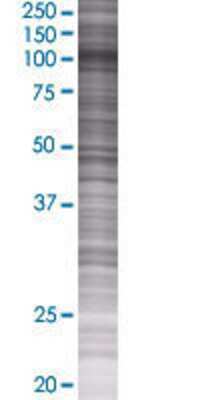BRD2 293T Cell Transient Overexpression Lysate
Novus Biologicals, part of Bio-Techne | Catalog # H00006046-T01

Key Product Details
Species
Human
Applications
Western Blot
Product Summary for BRD2 293T Cell Transient Overexpression Lysate
Quality control test: Transient overexpression cell lysate was tested with Anti-BRD2 antibody by Western Blots. Plasmid: pCMV-BRD2 full-length
Product Specifications
Specificity
BRD2 293T Cell Transient Overexpression Lysate(Denatured)
Type
293T Cell Transient Overexpression
Protein State
Denatured
Scientific Data Images for BRD2 293T Cell Transient Overexpression Lysate
Lane 1: BRD2 transfected lysate (88.22 KDa) Lane 2: Non-transfected lysate.
BRD2 transfected lysate.
Formulation, Preparation, and Storage
Formulation
1X Sample Buffer (50 mM Tris-HCl, 2% SDS, 10% glycerol, 300 mM 2-mercaptoethanol, 0.01% Bromophenol blue)
Concentration
mg/ml
Shipping
The product is shipped with dry ice or equivalent. Upon receipt, store it immediately at the temperature recommended below.
Storage
Store at -80C. Avoid freeze-thaw cycles.
Background: BRD2
BRD2 and the other BET proteins have been implicated in a variety of diseases and pathologies. The BET proteins are known drivers of cancer through mutation and over-expression (1). Recently, in studies examining the role of Type 2 diabetes and obesity in breast cancer progression, the BET proteins have been shown to be critical regulators of metabolism and metastasis and are co-activators for the transcription of genes that encode pro-inflammatory cytokines in immune cells infiltrating the breast cancer microenvironment (1). Accordingly, knockdown of Brd2 in mice protected the animals from developing Type 2 diabetes and stopped the inflammatory response typically elicited by obesity (4). BRD2 is also highly expressed in the brain and the gene has been shown to play a role in juvenile myoclonic epilepsy, a common form of epilepsy that typically reveals itself during adolescence (5). In addition to the brain, BRD2 is highly expressed in the bone marrow and consequently its kinase activity has been shown to increase upon cellular proliferation and is significantly elevated in the peripheral blood lymphocytes of lymphoma patients (2, 3).
Research has been done to better understand protein interactions with severe acute respiratory syndrome coronavirus-2 (SARS-CoV-2), the causative agent of the novel coronavirus disease 2019 (COVID-19), as possible targets for drug therapies. It was recently described that that the transmembrane envelope protein (E) of SARS-CoV-2 binds to both BRD2 and BRD4, suggesting that bromodomain inhibitors could be a potential drug target (6). More specifically, the bromodomain inhibitors could be relevant regarding the secondary immune-related consequences that arise from SARS-CoV-2 infection (6). Bromodomain inhibitors are currently the focus of multiple clinical trials as a potential therapeutic in cancer and pulmonary arterial hypertension (6).
References
1. Andrieu, G.P., Shafran, J.S., Deeney, J.T., Bharadwaj, K.R., Rangarajan, A., & Denis, G.V. (2018). BET proteins in abnormal metabolism, inflammation, and the breast cancer microenvironment. J Leukoc Biol. https://doi:10.1002/JLB.5RI0917-380RR
2. BRD2 bromodomain 2 (human), NCBI
3. Taniguchi, Y. (2016). The Bromodomain and Extra-Terminal Domain (BET) Family: Functional Anatomy of BET Paralogous Proteins. Int J Mol Sci. https://doi:10.3390/ijms17111849
4. Wang, F., Deeney, J.T., & Denis, G.V. (2013). Brd2 gene disruption causes "metabolically healthy" obesity: epigenetic and chromatin-based mechanisms that uncouple obesity from type 2 diabetes. Vitam Horm. https://doi:10.1016/B978-0-12-407766-9.00003-1
5. Gilsoul, M., Grisar, T., Delgado-Escueta, A.V., de Nijs, L., & Lakaye, B. (2019). Subtle Brain Developmental Abnormalities in the Pathogenesis of Juvenile Myoclonic Epilepsy. Front Cell Neurosci. https://doi:10.3389/fncel.2019.00433
6. Harrison, C. (2020). Drug researchers pursue new lines of attack against COVID-19. Nat Biotechnol. https://doi.org/10.1038/d41587-020-00013-z
Long Name
Bromodomain Containing 2
Alternate Names
FSRG1, RING3, RNF3
Gene Symbol
BRD2
Additional BRD2 Products
Product Documents for BRD2 293T Cell Transient Overexpression Lysate
Product Specific Notices for BRD2 293T Cell Transient Overexpression Lysate
This product is produced by and distributed for Abnova, a company based in Taiwan.
This product is for research use only and is not approved for use in humans or in clinical diagnosis. Lysates are guaranteed for 6 months from date of receipt.
